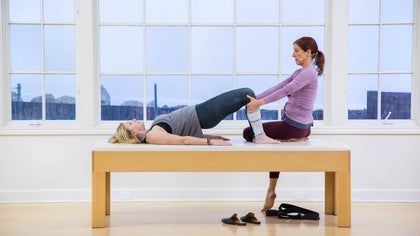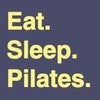Description
Note: Any assessments should be done by a licensed physical therapist as this is not within the scope of practice for a Pilates teacher.
About This Video
Transcript
Read Full Transcript
Hi, I'm Sherry bets and I'll be showing you what to do with a client that has a spondylolisthesis. So I have Skelly here that's going to help me with, uh, demonstrating that. And that's a big word. So we often abbreviate it, spawned d, which is nice. Um, Spani actually just means spine and list means a shift, like a listing of sh of a ship. And thesis means a pathology. So it means that one vertebrate is shifting on top of another one. So the spondylolisthesis normally or most often occurs at either l five s one, which is here and here, right s is the sacrum and l five is here and l four is sometimes spondolytic. And it often occurs in people that do a lot of extension sports like dancing, gymnastics, skating. People that fall onto their stomach and flip their feet over their head, sometimes have a hyperextension injury they call it.
And um, this needs to be differentiated a lot of times from what's called a pars fracture. And if you look at the side of the spine here, these are the Pars interarticularis and they're just a piece of bone that shut that juts out from the vertebral body. That helps to create that spinal canal that houses the spinal cord. And a lot of gymnast will have those Pars fractures they call them. And um, a lot of times you can feel or see a spawn d in a patient or a client. Um, and I help people identify that all the time, especially if they want to identify in their own body.
So we're going to focus on say l five s one as the spondolytic segment. And Amy's going to be our volunteer. She does not have a Spani I don't think. But, uh, we're gonna pretend like she does and I'll show you how to find it. First. I'm going to show you what I would do if Amy were laying on the table here.
And, um, I wanna feel the vertebral bodies to see if there's what we call a step off between one and the other. So here's the first fused vertebrae of the sacrum right here. And then right at the level of the ILIAC crest is going to be l four and a lot of times what you'll feel is like, oh, I can't, that vertebraes sunk deep in there. I can't feel it. So there's what we call a step off and then when we start working with the client that has this, then we can see that um, that vertebrae is getting deeper or is poorly controlled and it's actually you're able to do this. It's amazing. There are five grades of a normal spondylolisthesis and what I want you to understand is that there are, there are actually controllable neuromuscularly in some cases, not all, but in some and grade one would be when 25% of the vertebrae is shifted forward.
Grade two is when 50% is shifted forward on top of the other one. And then grade three is 75% and grade four is when that's hanging by allege and almost the whole vertebrae is forward. And grade five is pretty serious and definitely requires surgery. It's when the vertebrae has fallen off of the vertebrae above it. It's very usually a traumatic accident causes that. Um, but any, I've seen anything from a grade one to a grade four and I have seen people with a grade four that have had success with motor control programs, I. E.
[inaudible] based strengthening programs and core control programs. So I'm going to show you how that might look on Amy's body when we take her to the table. Okay?
So I'm gonna take her pants down again so we can see that area. All right. Um, probably want to ask for permission before you do that to your client. You know, if you're going to pull their pants down, you probably should tell them [inaudible]. All right, so here's our psis and if it goes straight across from there, that is our s to segment as one is going to be right above that. And then the seam that you feel like you feel a little drop-off, that's going to be l five so I can feel her l five pretty well right there. And then I feel l four here, which should be in the same alignment as her ILIAC crest. So you're going to come straight across from there. So what I want to do is, again, I was assuming that her l five segment was the issue.
So right here is where I want to focus my attention. Alright, so Amy, what I want you to do is lift your right leg up into the air and I'm watching to see if that segment drops. Okay. And then put it down. So basically what should happen is I shouldn't see any movement at that segment. And I did see some rotation, but I didn't see it drop into extension. All right, now let's do the left side
You'll feel the muscles contract on the opposite side, the lumbar muscles and then right left leg lifts. Okay, so she dropped down a little bit with that. Not that she has a spotty, but she just didn't control that as well as I'd like her to. So I'm going to have you anchor your pubic bone and your right p a s I s bound down and lift the left leg.
Let's see if she's got, okay. Still goes into some extension there. All right, so now I'll tuck your toes under if that right foot and left foot. Sorry. And then extend the leg. Yeah, so she can go into hip extension without extending here and without rotating. Now just see if you can point that left toe. Yes, that's better. And then take it down. Sometimes East centric. Lee, you can get into it easier.
Go ahead and then take it back down. That was much better. So I didn't see any movement there. Let's try that on the right side. Okay. Flex. That's right. Extend that knee and then just barely point that toe. So the, he, she starts to arch there a little bit. Okay. So those are the kinds of things you want to be watching for.
And if that is too challenging for someone with a [inaudible], which it may be, I'm gonna have you go up on your elbows and um, and get up on your knees. So yeah, be careful with that. Now go on your elbows. Sorry. I know. All right. Maximal exposure here. Okay, now I'm putting your hip and a little bit of flection so that she can have a little more success with that. So let's extend the right leg and then lift the leg up there. See no movement whatsoever. That was great, but that's barely getting her to neutral to get her into extension is another story, right? So we need to work on hip mobility here, which is super important for both to gnosis and spawned [inaudible] because they need better hip extension so that they don't bang up their lumbar spine all the time. Okay, so you're basically contacting the vertebrate all the time to see if that vertebraes sinking in. Any exercise that you do come down, right? You don't want that vertebrae to sync and then excellent.
Okay, so that's taking her from prone extension. That's one of the first things I want to master with a person with a Spani. All right, now I'll come onto your back, cover you back up and I'm going to put my hands under that spondolytic segment, which is l five and then keep your hands down because that's going to make you want to go into extension. So I want the hands put them on the rib cage. There you go. All right, now I'm just gonna have you bend your right knee. Great. And then bend the left knee. Excellent.
And there was no movement there. That was good. So she gets a a one out of five so far. All right. Now, right leg lifts just knee above the hip. [inaudible] left leg lifts, there's a little more work to lift that second leg and you see that the abdominal wall doesn't change shape and I didn't feel any forward movement or anterior movement of the owl five. All right, now touch the right toe to the floor and back up. And usually this is where you start to see arching and poor control. So a lot of times it's they don't have a great or yes, jutting down with the ribs or chin jutting up toward the ceiling.
They're trying to do everything they can to compensate [inaudible]. Okay, so if she does well with that, she gets a three out of five, right? Lifting that second leg gives her a two out of five and then extending one leg, lowering it down to the floor without moving that spondolytic segment and then back up and no change in the abdominal wall gives her a four out of five and then extend the other leg. Making sure that no effect of the PSOAS, the PSOAS is very important to think about with this Fante because that's the muscle that attaches to the front of the vertebrae. If it's not counterbalanced by the abdominals and the rectus abdominous obliques, trans versus holding that abdominal wall steady, then they will have an unopposed pull of the the vertebrae forward.
It will translate that vertebrae forward into extension. So show me one where you're not using your abdominals extent. Yeah, so [inaudible] and the back will arch the belly bulges. So you do not want to let them do that, but you also don't want to have them jam their back into the mat. So if they do that, then that's just pressing them into a posterior tilt. That's gonna create a faulty movement pattern.
You want true core control of that segment. And by core control we mean intra abdominal pressure so that the diaphragm pelvic floor transverse, a small tivos are all working together to provide intra abdominal pressure that's going to support that spine. It's like a suctioning of the spine. Right. Good. That's it. Now if someone is just having a really hard time controlling it, I may start them with a pushing down slightly onto my hand, a slight pelvic tilt just to get them started. Hold onto this leg. Now if they're very weak, press down again into my hand a little bit more. There you go.
And now lift this leg. Yes. So you're using some leverage to push into this. This hand puts your hands right here and push into your, your hands and let that help you push your back down on my fingers. Yes, that's good. So you're using a little bit of support. Let the glued on the right side help a little bit and then start doing those toe touches. Cause a lot of times I find that people are very weak in the abdominals and it's also um, kind of a traumatic thing to have us Bondi and it's like shoving forward or shearing in there and I think it shuts off the abdominals a lot of times.
Okay. So that would be something I would have you do now. Everything you do, no matter what exercise you're doing, you're going to be palpating that lumbar spine to make sure that they don't share forward or translate that vertebrae forward. So I am palpating and sideline and prone and quad pad, whatever exercise they're doing now, I wouldn't do things like, um, full rollback on the barrel bridging. Uh, I'm sorry, not bridging rollback or swan on the barrel, lots of big extension movement movements until they have really good control. So taking them into swan on the barrel into a flex position and just articulating up to a neutral drawing the tailbone down and lifting up that low belly kinda first as they do it and then they're ending up in a neutral position and not going into full extension is really helpful I think for training them. And um, getting up on the elbows lifting up too. So let's do one of those.
Go onto your elbows on your stomach and then take the tailbone down and lift the low valley app. So you're really trying to get that vertebrae. Now. Sometimes it doesn't go up and come back down. Sometimes the tailbone lifts, the vertebrae drops and they do it all with their hip flexors. So do a bad one. There you go. So that a hundred, it doesn't feel good, right?
So draw the tailbone down, press the pubic, bend into the mat first and then scoop it up, and then that vertebrae should lift up toward the ceiling and you should be able to feel that and it's not dropping in and there's no extension and that is a great one. Then do left leg bend and back down and right leg bend and back down one of my favorites because you're going into a little bit of thoracic extension. Another favorite is getting better thoracic extension so that you don't load up that segment. So if you've got good distribution of force and extension throughout the spine, you're not going to load up that, that l five segment into extension, which that's usually where it's painful. Um, so bridging on the barrel, which is a modified version of, of um, some of the barrel work where you put your feet on the rungs and then your back is on it. That's what we did in the thoracic mobility tutorial, and Amy was a subject and that one, and you're really getting that flex lumbar spine because you're really in this position here. And then extension through thoracic. That's a great one for [inaudible] too, and really making sure that they've got that contact of the lumbar spine against the barrel.
If you're doing like spine corrector roll down where you're sitting in front of the spine corrector, that's also a really good one too. And those are all shown in the thoracic mobility tutorial. Okay. So hopefully that gives you a good, some good information about dealing with a client that has a spondylolisthesis. So I'll see you at the next tutorial. Thanks so much for joining me.
The Teacher's Corner - Playlist 9: Common Back Problems
Comments
And PA for hosting the platform!
You need to be a subscriber to post a comment.
Please Log In or Create an Account to start your free trial.































